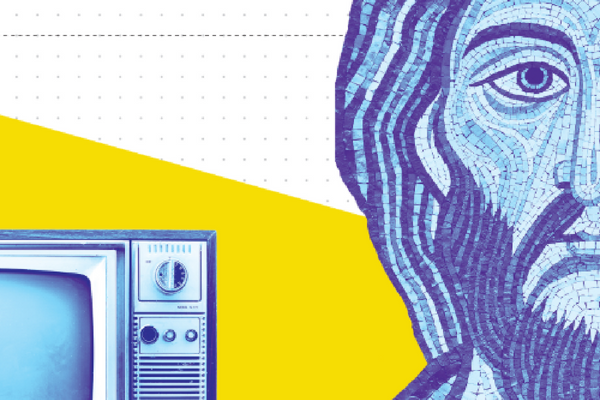
Today’s teenagers can be challenging to engage. After all, they are used to having all the information they need at their fingertips.
For youth leaders, we know the challenges that this brings for you. Tied with undying skepticism about anything and everything, it can be tough to not only engage this age group, but also to get them thinking about topics like their faith.
In comes T.B.D.: Think. Believe. Do., a new curriculum resource from Sparkhouse. Why is T.B.D. different? And what does it mean for your teens? Will you truly be able to get them to stop rolling their eyes at you?
We can’t promise you that, but we can promise a new curriculum unlike anything you’ve ever experienced for your youth before. To get all the facts, we asked Bryan Bliss, a youth leader and one of the creators of T.B.D, to tell us more about the curriculum and give us some insight on what it’s all about. Check out what he had to say!
What inspired you to develop the T.B.D series?
T.B.D. focuses on the ongoing process of faith formation – especially in the lives of teenagers. So much curriculum centers around the idea that a high school student will participate in this four-lesson study on, say, prayer and will magically come out on the other side with a complete picture of how they think about prayer both theologically and practically for the rest of their lives.
That, frankly, is maddening. And it’s an impossible standard to hold teenagers too, especially when we never do that for adults. The metaphor I like to use is that of a junior varsity football player. Nobody would ever throw them onto a field with professional athletes and then shake their head with disappointment when they don’t succeed! T.B.D. came out of a place of wanting to honor the faith development process, while turning over some of that process to the actual teenagers who are living it.
What are the main topics that are discussed in the T.B.D series?
New topics for T.B.D. release quarterly. Prayer is currently available, and Sin is available for pre-order and will be released on August 21). Our next two units are Mission (available later this year) and Salvation (released in early 2019).
These topics offer theological and practical applications in the lives of students. They likely have some opinions, some experiences, with these topics as well. All of that leads to a small group experience that fosters and encourages both conversation and growth.
How does T.B.D work?
T.B.D. is based around the idea that faith is an ongoing process, which acknowledges that every kid who walks into that small group room is at a different place in their faith. As they walk in, they’re asked to consider what we call a “provocative statement”, a assertion that is meant to spark conversation. Say the provocative statement is, “There’s a right way to pray.” Some kids might immediately nod their head – of course this is true! Others might give it a serious side-eye, because…there’s no way that holds up with their own experiences. The beauty of this is obvious: no matter where a kid is in their faith, they have an immediate connection to the lesson.
From there, we ask students to respond to the provocative statement using sticky notes. At this point, anything goes. We ask students to be honest when confronting the lesson – how do they feel right now. How have they experienced this in their life? What have they learned so far? This idea generation is the engine for the entire lesson.
However, we don’t let students rest on their personal thoughts and experiences. As the lesson progresses, students are asked to consider facts from Christian tradition, theology, and the Bible. At each step they are asked to look at the information that’s already on the board and adjust it accordingly as new evidence comes to light. The entire process is meant to challenge students to hear new information and balance it against their own thoughts and experiences, as well as the experiences and thoughts of the group.
After they’ve encountered all the new information, students are asked to think about the provocative statement one last time. How would they rewrite it? What revisions would they make? As a group, they construct a new provocative statement that is true for them in that moment – something that they can take out into the world and test.
Each lesson ends with an opportunity to do just that. The group comes up with a “Big Action”, a way to test the provocative statement in the world. Say the new provocative statement is, “There’s a right way to pray in certain situations.” A group might consider using different body prayers throughout the week, or even intentionally using prayers of supplication or intercession. This does two things. First, it allows the group to see how theology is applied in their lives. Second, it reminds them that all theology is a best guess!
What is the main goal of the T.B.D series?
With T.B.D., our goal focused on creating a curriculum and resource toolkit for leaders to turn ownership of faith over to teenagers. This, ultimately, sounds risky. But it’s also the only way, in my mind, that we can expect teenagers to claim their faith in dynamic and meaningful ways.
As the developer behind the series, what is your favorite part about T.B.D?
I absolutely love the design! It’s very clean and, even without the actual text of the lessons, impacts participants – no matter their engagement level. My hope is that teenagers (and leaders) will be struck by the beauty of the student journals, and it will help spur discussions and engage teens to truly think about their faith and the provocative statements.
How can T.B.D benefit youth and youth ministry leaders?
My hope is this question is already evident after reading the other answers! That said, this resource is an opportunity for both youth and youth leaders to take their faith formation to a new and exciting place.
Now with the insider details behind T.B.D, we hope you are ready to help your teens take their faith to the next level!
Interested in learning more? Check out our website for more information and details on how you can get started with T.B.D.




